- Joined
- Oct 9, 2007
- Messages
- 47,511 (7.49/day)
- Location
- Hyderabad, India
| System Name | RBMK-1000 |
|---|---|
| Processor | AMD Ryzen 7 5700G |
| Motherboard | ASUS ROG Strix B450-E Gaming |
| Cooling | DeepCool Gammax L240 V2 |
| Memory | 2x 8GB G.Skill Sniper X |
| Video Card(s) | Palit GeForce RTX 2080 SUPER GameRock |
| Storage | Western Digital Black NVMe 512GB |
| Display(s) | BenQ 1440p 60 Hz 27-inch |
| Case | Corsair Carbide 100R |
| Audio Device(s) | ASUS SupremeFX S1220A |
| Power Supply | Cooler Master MWE Gold 650W |
| Mouse | ASUS ROG Strix Impact |
| Keyboard | Gamdias Hermes E2 |
| Software | Windows 11 Pro |
Radeon R9 290X is looking increasingly good on paper. Most of its rumored specifications, and SEP pricing were reported late last week, but the ones that eluded us were clock speeds. A source that goes by the name Grant Kim, with access to a Radeon R9 290X sample, disclosed its clock speeds, and ran a few tests for us. To begin with, the GPU core is clocked at 1050 MHz. There is no dynamic-overclocking feature, but the chip can lower its clocks, taking load and temperatures into account. The memory is clocked at 1125 MHz (4.50 GHz GDDR5-effective). At that speed, the chip churns out 288 GB/s of memory bandwidth, over its 512-bit wide memory interface. Those clock speeds were reported by the GPU-Z client to us, so we give it the benefit of our doubt, even if it goes against AMD's ">300 GB/s memory bandwidth" bullet-point in its presentation.
Among the tests run on the card include frame-rates and frame-latency for Aliens vs. Predators, Battlefield 3, Crysis 3, GRID 2, Tomb Raider (2013), RAGE, and TESV: Skyrim, in no-antialiasing, FXAA, and MSAA modes; at 5760 x 1080 pixels resolution. An NVIDIA GeForce GTX TITAN was pitted against it, running the latest WHQL driver. We must remind you that at that resolution, AMD and NVIDIA GPUs tend to behave a little differently due to the way they handle multi-display, and so it may be an apples-to-coconuts comparison. In Tomb Raider (2013), the R9 290X romps ahead of the GTX TITAN, with higher average, maximum, and minimum frame rates in most tests.

RAGE
The OpenGL-based RAGE is a different beast. With AA turned off, the R9 290X puts out an overall lower frame-rates, and higher frame latency (lower the better). It gets even more inconsistent with AA cranked up to 4x MSAA. Without AA, frame-latencies of both chips remain under 30 ms, with the GTX TITAN looking more consistent, and lower. At 4x MSAA, the R9 290X is all over the place with frame latency.
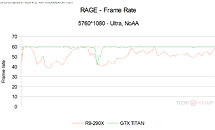



TESV: Skyrim
The tester somehow got the game to work at 5760 x 1080. With no AA, both chips put out similar frame-rates, with the GTX TITAN having a higher mean, and the R9 290X spiking more often. In the frame-latency graph, the R9 290X has a bigger skyline than the GTX TITAN, which is not something to be proud of. As an added bonus, the VRAM usage of the game was plotted throughout the test run.
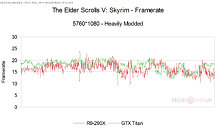
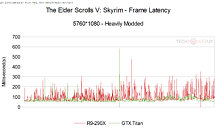

GRID 2
GRID 2 is a surprise package for the R9 290X. The chip puts out significantly, and consistently higher frame-rates than the GTX TITAN at no-AA, and offers lower frame-latencies. Even with MSAA cranked all the way up to 8x, the R9 290X holds out pretty well on the frame-rate front, but not frame-latency.
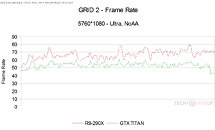
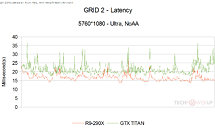


Crysis 3
This Cryengine 3-based game offers MSAA and FXAA anti-aliasing methods, and so it wasn't tested without either enabled. With 4x MSAA, both chips offer similar levels of frame-rates and frame-latencies. With FXAA enabled, the R9 290X offers higher frame-rates on average, and lower latencies.
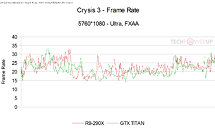

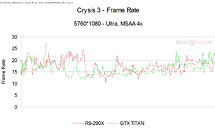
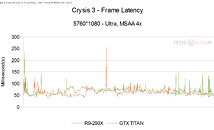
Battlefield 3
That leaves us with Battlefield 3, which like Crysis 3, supports MSAA and FXAA. At 4x MSAA, the R9 290X offers higher frame-rates on average, and lower frame-latencies. It gets better for AMD's chip with FXAA on both fronts.




Overall, at 1050 MHz (core) and 4.50 GHz (memory), it's advantage-AMD, looking at these graphs. Then again, we must remind you that this is 5760 x 1080 we're talking about. Many Thanks to Grant Kim.
View at TechPowerUp Main Site
Among the tests run on the card include frame-rates and frame-latency for Aliens vs. Predators, Battlefield 3, Crysis 3, GRID 2, Tomb Raider (2013), RAGE, and TESV: Skyrim, in no-antialiasing, FXAA, and MSAA modes; at 5760 x 1080 pixels resolution. An NVIDIA GeForce GTX TITAN was pitted against it, running the latest WHQL driver. We must remind you that at that resolution, AMD and NVIDIA GPUs tend to behave a little differently due to the way they handle multi-display, and so it may be an apples-to-coconuts comparison. In Tomb Raider (2013), the R9 290X romps ahead of the GTX TITAN, with higher average, maximum, and minimum frame rates in most tests.

RAGE
The OpenGL-based RAGE is a different beast. With AA turned off, the R9 290X puts out an overall lower frame-rates, and higher frame latency (lower the better). It gets even more inconsistent with AA cranked up to 4x MSAA. Without AA, frame-latencies of both chips remain under 30 ms, with the GTX TITAN looking more consistent, and lower. At 4x MSAA, the R9 290X is all over the place with frame latency.




TESV: Skyrim
The tester somehow got the game to work at 5760 x 1080. With no AA, both chips put out similar frame-rates, with the GTX TITAN having a higher mean, and the R9 290X spiking more often. In the frame-latency graph, the R9 290X has a bigger skyline than the GTX TITAN, which is not something to be proud of. As an added bonus, the VRAM usage of the game was plotted throughout the test run.



GRID 2
GRID 2 is a surprise package for the R9 290X. The chip puts out significantly, and consistently higher frame-rates than the GTX TITAN at no-AA, and offers lower frame-latencies. Even with MSAA cranked all the way up to 8x, the R9 290X holds out pretty well on the frame-rate front, but not frame-latency.




Crysis 3
This Cryengine 3-based game offers MSAA and FXAA anti-aliasing methods, and so it wasn't tested without either enabled. With 4x MSAA, both chips offer similar levels of frame-rates and frame-latencies. With FXAA enabled, the R9 290X offers higher frame-rates on average, and lower latencies.




Battlefield 3
That leaves us with Battlefield 3, which like Crysis 3, supports MSAA and FXAA. At 4x MSAA, the R9 290X offers higher frame-rates on average, and lower frame-latencies. It gets better for AMD's chip with FXAA on both fronts.




Overall, at 1050 MHz (core) and 4.50 GHz (memory), it's advantage-AMD, looking at these graphs. Then again, we must remind you that this is 5760 x 1080 we're talking about. Many Thanks to Grant Kim.
View at TechPowerUp Main Site
Last edited:






 . Personally I've sold my GTX 780 and am looking to spend $500-800 on a card or pair of cards to run faster. Right now it's not looking like this one's going to be anything particularly better, unfortunately.
. Personally I've sold my GTX 780 and am looking to spend $500-800 on a card or pair of cards to run faster. Right now it's not looking like this one's going to be anything particularly better, unfortunately.




